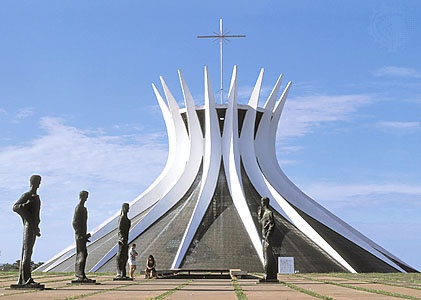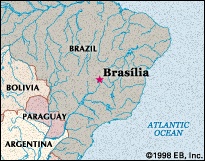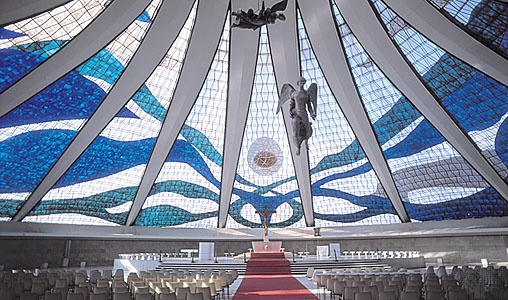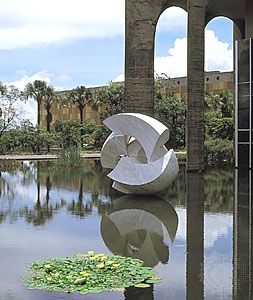Brasília
Brazil
Introduction


city, federal capital of Brazil. It is located in the Federal District (Distrito Federal) carved out of Goiás state on the central plateau of Brazil. At an elevation of some 3,500 feet (1,100 metres), it lies between the headwaters of the Tocantins (Tocantins River), Paraná (Paraná River), and São Francisco (São Francisco River) rivers. Because of its unique city plan and architecture, as well as its unprecedented role in the development of the Brazilian interior, the city was designated a UNESCO World Heritage site in 1987. Area Federal District, 2,240 square miles (5,802 square km). Pop. (2005 est.) city, 2,231,100; Federal District, 2,333,108; metropolitan area, 3,454,961.
Physical and human geography
The landscape
City layout

 The plan of the central city has been likened to a bird, a bow and arrow, or an airplane. Designed by the Brazilian architect Lúcio Costa (Costa, Lúcio), its form is emphasized by the Highway Axis (Eixo Rodoviário), which curves from the north to the southwest and links Brasília's main residential neighbourhoods, and the straight Monumental Axis (Eixo Monumental), which runs northwest-southeast and is lined by federal and civic buildings. At the northwestern end of the Monumental Axis are federal district and municipal buildings, while at the southeastern end, near the middle shore of Lake Paranoá, stand the executive, judicial, and legislative buildings around the Square of Three Powers, the conceptual heart of the city. These and other major structures were designed by the Brazilian architect Oscar Niemeyer (Niemeyer, Oscar). In the Square of Three Powers, he created as a focal point the dramatic Congressional Palace, which is a composition of five parts: twin administrative towers flanked by a large, white concrete dome (the meeting place of the Senate) and by an equally massive concrete bowl (the Chamber of Deputies), which is joined to the dome by an underlying, flat-roofed building. A series of low-lying annexes (largely out of sight) flank both ends. Also in the square are the glass-faced Planalto Palace (housing the presidential offices) and the Palace of the Supreme Court. Farther east, on a triangle of land jutting into the lake, is the Palace of the Dawn (Palácio da Alvorada; the presidential residence). Between the federal and civic buildings on the Monumental Axis is the city's cathedral, considered by many to be Niemeyer's finest achievement (see photographs of the exterior-->
The plan of the central city has been likened to a bird, a bow and arrow, or an airplane. Designed by the Brazilian architect Lúcio Costa (Costa, Lúcio), its form is emphasized by the Highway Axis (Eixo Rodoviário), which curves from the north to the southwest and links Brasília's main residential neighbourhoods, and the straight Monumental Axis (Eixo Monumental), which runs northwest-southeast and is lined by federal and civic buildings. At the northwestern end of the Monumental Axis are federal district and municipal buildings, while at the southeastern end, near the middle shore of Lake Paranoá, stand the executive, judicial, and legislative buildings around the Square of Three Powers, the conceptual heart of the city. These and other major structures were designed by the Brazilian architect Oscar Niemeyer (Niemeyer, Oscar). In the Square of Three Powers, he created as a focal point the dramatic Congressional Palace, which is a composition of five parts: twin administrative towers flanked by a large, white concrete dome (the meeting place of the Senate) and by an equally massive concrete bowl (the Chamber of Deputies), which is joined to the dome by an underlying, flat-roofed building. A series of low-lying annexes (largely out of sight) flank both ends. Also in the square are the glass-faced Planalto Palace (housing the presidential offices) and the Palace of the Supreme Court. Farther east, on a triangle of land jutting into the lake, is the Palace of the Dawn (Palácio da Alvorada; the presidential residence). Between the federal and civic buildings on the Monumental Axis is the city's cathedral, considered by many to be Niemeyer's finest achievement (see photographs of the exterior--> and interior-->
and interior--> ). The parabolically shaped structure is characterized by its 16 gracefully curving supports, which join in a circle 115 feet (35 metres) above the floor of the nave; stretched between the supports are translucent walls of tinted glass. The nave is entered via a subterranean passage rather than conventional doorways. Other notable buildings are Buriti Palace, Itamaraty Palace (the Palace of Foreign Affairs), the National Theatre, and several foreign embassies that creatively embody features of their national architecture.
). The parabolically shaped structure is characterized by its 16 gracefully curving supports, which join in a circle 115 feet (35 metres) above the floor of the nave; stretched between the supports are translucent walls of tinted glass. The nave is entered via a subterranean passage rather than conventional doorways. Other notable buildings are Buriti Palace, Itamaraty Palace (the Palace of Foreign Affairs), the National Theatre, and several foreign embassies that creatively embody features of their national architecture. Both low-cost and luxury housing were built by the government in the central city area. The residential zones of the inner city are arranged into superquadras (“superblocks”), groups of apartment buildings along with a prescribed number and type of schools, retail stores, and open spaces. At the northern end of Lake Paranoá, separated from the inner city, is a peninsula upon which stand many fashionable homes; a similar neighbourhood exists on the southern lakeshore. Originally, the city planners envisioned extensive public areas along the shores of the artificial lake, but, during early development of the area, private clubs, hotels, and upscale residences and restaurants gained footholds around the water. Set well apart from the city are suburban “satellite towns,” including Gama, Ceilândia, Taguatinga, Núcleo Bandeirante, Sobradinho, and Planaltina. These areas were not planned as permanent settlements and thus offer stark contrasts to the symmetry and spacing of Brasília.
Both low-cost and luxury housing were built by the government in the central city area. The residential zones of the inner city are arranged into superquadras (“superblocks”), groups of apartment buildings along with a prescribed number and type of schools, retail stores, and open spaces. At the northern end of Lake Paranoá, separated from the inner city, is a peninsula upon which stand many fashionable homes; a similar neighbourhood exists on the southern lakeshore. Originally, the city planners envisioned extensive public areas along the shores of the artificial lake, but, during early development of the area, private clubs, hotels, and upscale residences and restaurants gained footholds around the water. Set well apart from the city are suburban “satellite towns,” including Gama, Ceilândia, Taguatinga, Núcleo Bandeirante, Sobradinho, and Planaltina. These areas were not planned as permanent settlements and thus offer stark contrasts to the symmetry and spacing of Brasília.The city has been acclaimed for its use of modernist architecture on a grand scale and for its somewhat utopian city plan; however, it has been roundly criticized for much the same reasons. After a visit to Brasília, the French writer Simone de Beauvoir (Beauvoir, Simone de) complained that all of its superquadras exuded “the same air of elegant monotony,” and other observers have equated the city's large open lawns, plazas, and fields to wastelands. As the city has matured, some of these have gained adornments, and many have been improved by landscaping, giving some observers a sense of “humanized” spaciousness.
Climate
The climate is warm and mild with average minimum and maximum temperatures of about 57° F (14° C) and 81° F (27° C), respectively. Rainfall averages some 60 inches (1,600 mm) per year with a dry season from March to October, and humidity is generally between 40 and 80 percent (it fell to 11 percent during a drought in 1994).
The people
Brasília's inhabitants include both foreigners (notably ambassadorial staff) and Brazilians, some of whom came from economically impoverished areas in the Northeast to take part in the city's building. Later, many more moved from Rio de Janeiro and other urban centres to staff the myriad government agencies. The population of both central and satellite areas grew tremendously in the first decade of the city's construction; the city alone held some 64,000 inhabitants in 1959, and it was home to more than 272,000 by 1970. In the Federal District, 139,796 persons were counted in the 1960 census, and 537,492 were enumerated 10 years later. The populations of the city and the Federal District soon reached a rough parity, the number of residents in each exceeding two million in the early 21st century.
The economy
Services and industries
The major roles of construction and of services (government, communications, banking and finance, food production, entertainment, and legal services) in Brasília's economy reflect the city's status as a governmental rather than an industrial centre. Industries connected with construction, food processing, and furnishings are important, as are those associated with publishing, printing, and computer software. Many nationwide companies and associations have headquarters there.
Transportation
Highways and air routes link Brasília with the rest of the nation, and there is regular national and international air service. Railways connect the city with Rio de Janeiro and São Paulo.
Within the city itself, automobiles and buses are the main forms of urban transportation because of the primacy afforded expressways in the city's design and the considerable distances between inner-city neighbourhoods.. The city also has an underground transit system.
Local government
Until 1990 the governor of the Federal District was appointed by the Brazilian president and confirmed by the Senate. In that year, in keeping with provisions of the 1988 constitution, Joaquim Domingos Roriz was chosen in the first election for district governor. Reporting to the governor are numerous secretaries responsible for public works, welfare, education, law enforcement, and other concerns. The Senate acts as the legislative branch of local government. In 1986 the voters in the district elected their first congressional representatives to the national assembly, and since that time elections have been conducted as in any of Brazil's states.
Cultural life
 The University of Brasília (1962) is central to much of the city's cultural life. The Cultural Foundation sponsors many national meetings in the arts and letters, and several foreign information centres are available. Housed in an irregularly shaped pyramidal structure, the National Theatre features dramatic, symphonic, and operatic works. Historical institutions include the Museum of Brasília, with a historical record of Brasília's creation, the Federal Reserve Museum, and the Image and Sound Museum of the Institute of History and Geography.
The University of Brasília (1962) is central to much of the city's cultural life. The Cultural Foundation sponsors many national meetings in the arts and letters, and several foreign information centres are available. Housed in an irregularly shaped pyramidal structure, the National Theatre features dramatic, symphonic, and operatic works. Historical institutions include the Museum of Brasília, with a historical record of Brasília's creation, the Federal Reserve Museum, and the Image and Sound Museum of the Institute of History and Geography.An initial lack of recreational facilities has been overcome in Brasília by numerous cinemas and nightclubs and a proliferation of sporting grounds in the city and suburbs. The city also has many swimming pools. A zoological park and forest reserves have been developed, and boating and fishing are popular activities on Lake Paranoá and the nearby rivers. The city boasts two professional soccer stadiums, one accompanied by an indoor arena for other sports.
History
The idea of a capital city located in the interior was proposed in 1789 by Joaquim José da Silva Xavier (Silva Xavier, Joaquim José da), a leader in the independence movement. It was reiterated in 1822 (when Brazil gained its independence from Portugal) by the scientist and politician José Bonifácio de Andrada e Silva (Andrada e Silva, José Bonifácio de), and it was embodied in the constitution of 1891. More than 50 years passed, however, before the logistical, political, and economic barriers to such a move could be overcome. Eight years of surveying and testing in the interior preceded the selection of Brasília's present site in 1956. That same year marked the beginning of work under the leadership of President Juscelino Kubitschek de Oliveira (Kubitschek, Juscelino). Following the establishment of an airstrip, heavy machinery was flown in, and construction crews began to carve out city streets, the artificial lake, and the foundations of the principal buildings. Simultaneously, thousands of miles of interregional highways were created or extended to link the district with cities in the south ( Belo Horizonte, Rio de Janeiro, and São Paulo), north ( Belém), and east ( Fortaleza, Recife, and Salvador). In April 1960 the Square of Three Powers was dedicated, and the federal government began its move from Rio de Janeiro, albeit at a far slower pace than was initially envisioned. The city stood as a symbol to many Brazilians of the future growth of the nation. It embodied the national will to overcome chronic economic and social problems through the exploitation of the country's vast untapped interior; however, the great cost of its construction and the radical nature of its architecture were the subjects of intense criticism. Also of concern during subsequent decades was the environmental damage resulting from expansion of the region's transportation infrastructure, which greatly facilitated access to the Amazon Rainforest to the north.
Following the military overthrow of the government in 1964, work on the city continued, although many of Niemeyer and Costa's original plans were scrapped by the regime, who disagreed with their allegedly “Marxist” tendencies. Civilian government was restored in 1985, and symbolic changes were made in the city's structures; for example, the marble facing on the Ministry of Justice was removed, and the building was brought back into accordance with Niemeyer's original blueprints.
By the end of the 20th century, the consequences of Brasília's rapid construction—from cracks in its concrete plazas to the deterioration of its lower-income housing—had begun to show. The social problems and disruptions of basic services that accompanied rapid, uncontrolled population growth—issues common to other large Brazilian cities—also were major concerns. The introduction of self-government during the 1990s spawned progressive administrations that attempted to address these problems. Lake Paranoá became increasingly polluted until a water treatment program was inaugurated; by the late 1990s the lake was again serving as a popular recreational area.
Additional Reading
Alex Shoumatoff, The Capital of Hope (1980, reprinted 1990), discusses the development of Brasília. James Holston, The Modernist City: An Anthropological Critique of Brasília (1989), examines the intentions of Brasília's planning and development and compares them with the reality of the city's social structures. “Interview: Oscar Niemeyer Talks to Edouard Bailby,” UNESCO Courier, 45:4–7 (June 1992), is also useful.
- ITT Corporation
- iTunes
- Iturbide, Agustín de
- Ituri Forest
- Itzamná
- Itzhak Ben-Zvi
- Itzhak Perlman
- Itá
- Itō
- Itō Hirobumi
- Itō Jakuchū
- Itō Jinsai
- IUD
- Iuliu Maniu
- IUPAC names of unbranched alkanes
- Ivan Albright
- Ivan Aleksandrovich Goncharov
- Ivan Alekseyevich Bunin
- Ivan Andreyevich Kairov
- Ivan Andreyevich Krylov
- Ivan Asen I
- Ivan Asen II
- Ivan Bella
- Ivan Cankar
- Ivan Evstatiev Geshov